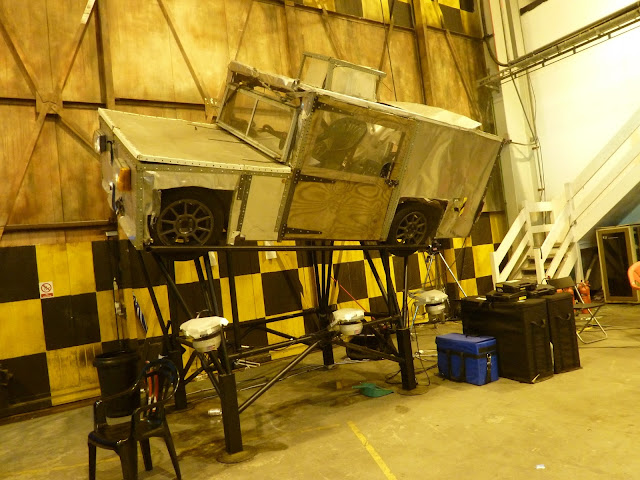What do you suppose goes through a person’s mind when they
decide they want to build their own car?
For some of them, it will be a craving for the jigsaw-like
challenge of putting together a lightweight sports car such as a Caterham
7. All the pieces arrive from the
factory and the prospective Caterham owner will then have several hundred hours
of screwing (probably the only kind they’re going to get for the duration of
the project), fixing and fettling to look forward to before attempting to
summon up enough courage to clamber into a car they’ve built themselves and
daring to put it on the road.
It takes a
special sort of bravery to take on this kind of project; not only is it quite a
substantial outlay for something that may never be roadworthy if they give up
half way through, but imagine what it would be like to drive a car where you knew with absolute certainty that some
of the bits ended up in the dustbin by accident, and there didn’t seem to be
enough of a certain type of bolt, and not only that a few shortcuts were taken
but exactly what those shortcuts were…
The rewards, however, can be enormous. Choose the right car, take your time building
it, follow the instructions to the letter and make sure someone with proper
knowledge has a look at any bits you aren’t sure about and you should end up with an entertaining
little head-turner that gives you the added satisfaction, after a thoroughly
enjoyable bit of B-road blatting, to step from the car, look back and say, “I
made that.”
Of course, the Caterham route isn’t the cheapest way around
things, and building something from that level of disassembly is a bit too
daunting for some hobbyist automotive engineers. For them may lie the path of the ‘Special’, a
replacement body shell, and sometimes interior, for a particular car. Although less common than they once were, the
Special is a way of getting your hands dirty and ending up with something a bit
different without needing to break everything down to bare bolts or ending up
with a decree absolute to hang alongside the car’s MOT certificate.
For other hobbyists, the kit car approach allows them to replicate
a dream car they might otherwise never be able to afford, with levels of
accuracy from hair-splittingly good to hair-raisingly terrible. You could go for something like the Hawk
Stratos – where any panel could be swapped with its Lancia original without
difficulty – or maybe a classic Ferrari or Porsche (a former neighbour of mine
had an absolutely perfect 356 Speedster replica, but had to admit the game was
up when I asked him why the DVLA thought it was an old Volkswagen…), if they’re
more your style. It’s an option that
gives you plenty of scope when it comes to under the bonnet, and with something
to suit almost all budgets and tastes, replica enthusiasts are a broad church.
But for a select few, a buying a kit or modifying an
existing vehicle simply isn’t enough.
We’ve all heard tales about the bloke who scratchbuilt a racing car in
his kitchen, and the man who had part of his basement demolished to free the
replica Lamborghini he’d spent a decade building under his house, but for the
most deluded enthusiastic shed engineer, even replicating someone else’s
work from first principles isn’t enough.
No, for these few, these happy few – often diving in with no design,
systems, materials or engineering knowledge or experience – only building and driving
a car they’ve designed themselves will do.
You have to wonder what goes through their minds.
There are low-volume manufacturers in the UK, who, by means
of eccentric blokes in sheds, may get very few cars on the road, but when you
see a Bristol or a Noble or a Lightning GT, at least they do it with style.
Unfortunately for the chaps and occasional chappesses fettling
away at home, most of their end results tend to look like distant cousins of Top Gear’s home made range-extended
electric effort Geoff (a car almost as successful as the Vauxhall Ampera, and
with about as many examples on the road).
In fact, several years prior to Geoff’s inception, I saw something
wobbling around a roundabout in Plymouth that could have been prototype for
Clarkson et al’s wooden-doored aluminium box-on-wheels, right down to the bits
of shelf unit used in its construction…
As for this Q-plate catastrophe, I think the photograph says
it all…
It’s certainly a head turner, but perhaps not in the way its
creator intended. Reactions have ranged
from ‘Oh, it’s a Smart if they were from the 70s,’ to ‘Have they brought back
the Invacar?’ and simply ‘What the bloody hell’s that?!’
Actually, the Q-plate is a very major way these home-made
motors vary from the Top Gear Technology Centre effort – in the end, enough of
the TVR that underpinned Geoff was recognisable enough that it retained its
original registration number, like a Special or a kit replica.
And yet I can’t help having a certain admiration for people
who do decide to use a car they’ve designed and built themselves. It must take balls of titanium and a hide
like a rhino’s to get into something that will be laughed out of town and will
kill you very messily indeed in even a relatively gentle accident. As far as I can tell in the example above,
the side impact protection consists mainly of the driver’s elbow. Would you want to drive a car you’d built in
your spare time in a shed? I know I wouldn’t. I’d be constantly waiting for it to hit a
pothole and collapse.
So shed-based petrolheads currently taking to the roads in
cars of your own design and manufacture, I salute you. You are as certifiable as your cars, but you
are far braver than I.



